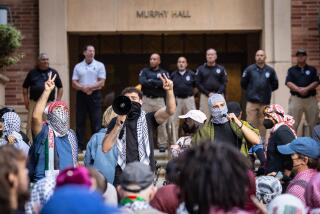A blow against Beijing’s security
- Share via
XIAHE, CHINA — A question the Chinese Communist Party will no doubt be asking itself for years to come is how its vast security apparatus could stumble so badly to allow the situation in ethnically Tibetan regions of China to get so out of control.
Although the budgets and staffing levels of China’s police and intelligence agencies are a state secret, it’s clear they are among the largest in the world, with roots that penetrate deep into neighborhoods, companies and even monasteries.
Yet a ground-level view I received of the unrest and crackdown at Xiahe in Gansu province last week offered a look at how flat-footed the vaunted security machine could be, at least here, despite its size, budget and ability to act without warrants or other democratic niceties. When the first signs of unrest hit Friday, the police were caught unaware. They rallied later that day but apparently underestimated the people’s willingness to protect the monks. Having put out a small skirmish, the police seemed taken by surprise the next day when the protesters came back far stronger. And many of the police tactics appeared to inflame passions rather than calm the situation.
The long, winding mountain road up to Xiahe from Lanzhou, the regional capital, passes first through Han Chinese territory with all its frenzied economic prowess and then a Hui-minority Muslim area with its prominent mosques before finally, as snowcapped peaks come into view, entering the land of Tibetan Buddhism.
After dozens of dirt-poor villages, with their shaggy goatherds and hay drying on poles, the gold-trimmed and red-etched buildings of Xiahe’s Labrang Monastery complex border on the magical.
The monastery, a maze of temples, schools and dorms, is a city within a city, considered among the holiest sites outside the Tibetan Autonomous Region because it is home to the Living Buddha, the religion’s third-most important leader after the Dalai Lama and the Panchen Lama.
Around 10 a.m. Saturday, hundreds of monks emerged from the monastery into the city’s streets, attracting attention from pilgrims in colorful traditional clothing, including men in coats with sleeves extending nearly to their knees.
The growing crowd that now numbered as many as 1,000, according to witnesses and reports that leaked out to foreign activist groups later, headed for Choeten Karpo, or White Stupa. The procession proceeded to circle the religious building, which is vaguely reminiscent of a cone, three times and burned incense.
Soon chants and slogans rose from the assembled group praising the exiled Dalai Lama, the spiritual head of Tibetan Buddhism, a figure reviled by Beijing as a “splittist” intent on wrenching the territory from China. Cries of “Long live the Dalai Lama!” and “Pro-Independence!” rang out through the streets.
Intoxicated with uncontested power, the crowd soon marched toward the county police station.
Accounts differ on who made the first provocative move, with Beijing claiming the crowd attacked first and Tibetan advocates saying the police did. At any rate, by some accounts, about 20 officers fired live rounds, roughed up and started arresting protesters and tried to quell their passions with tear gas. All the while, the crowd was breaking windows and hacking at the police station before moving on to overturn cars and smash buildings, part of a now-familiar pattern of unleashed rage and destruction captured in videos from Lhasa, Tibet’s capital, and beyond.
The police thought they had beat back the challenge, but by the afternoon as many as 10,000 protesters appeared, marching from a bridge at the center of town. They raised the Tibetan flag at a middle school and attacked more buildings, resulting at some point in four deaths and scores of arrests, according to witnesses and reports that were spread to outside groups but could not be independently confirmed.
We arrived just in time to see the immediate aftermath. About 28 hours after the start of trouble in Xiahe, and nearly a week after trouble started brewing in Lhasa, China’s security shield still appeared clunky and ill-prepared for the size and strength of the Tibetan rage. As well, at least for a short time, the security forces were unsuccessful at keeping outside observers from this city of 150,000 people.
The stream of paramilitary officers fanning out through town in their green uniforms clashed with the crimson color of the monks’ robes.
Soon the crowd’s bravado dissipated as the realization of how much people could pay for venting years of rage began to sink in. The protesters knew what this show of force meant; they’d been here before, and it wasn’t good.
Within hours, roadblocks were firmly in place much farther down the valley, the police at every juncture were now on their toes, and there were no side roads on which to detour. The security machine was now making up with sheer muscle what it lacked in vigilance, its full weight bearing down on the monks and pilgrims, with outside observers kept over the horizon just the way the authorities wanted it.
“The police pushed and the people reacted,” said a Tibetan businessman who declined to identify himself, given restrictions against speaking to foreigners. “Now soon everything will be quiet.”
--
More to Read
Sign up for Essential California
The most important California stories and recommendations in your inbox every morning.
You may occasionally receive promotional content from the Los Angeles Times.












